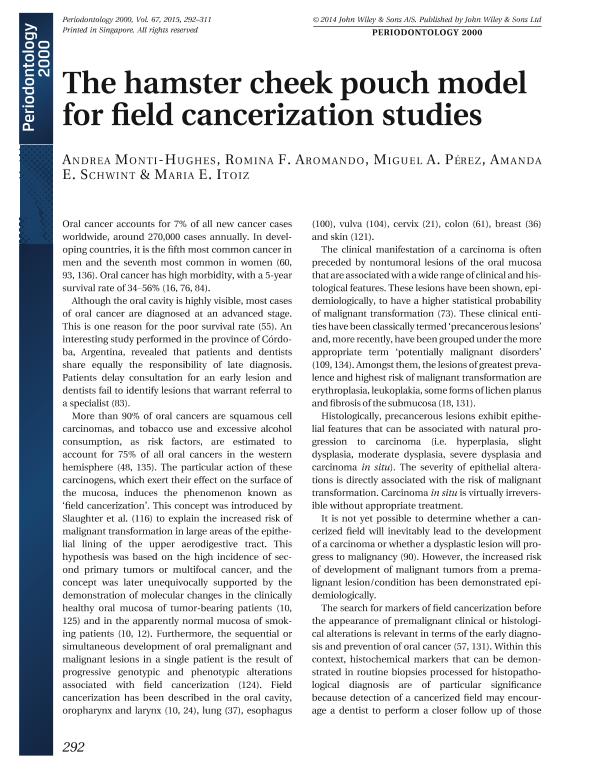Mostrar el registro sencillo del ítem
dc.contributor.author
Monti Hughes, Andrea

dc.contributor.author
Aromando, Romina Flavia

dc.contributor.author
Pérez, Miguel A.
dc.contributor.author
Schwint, Amanda Elena

dc.contributor.author
Itoiz, María Elina

dc.date.available
2018-04-10T20:02:36Z
dc.date.issued
2015-02
dc.identifier.citation
Monti Hughes, Andrea; Aromando, Romina Flavia; Pérez, Miguel A.; Schwint, Amanda Elena; Itoiz, María Elina; The hamster cheek pouch model for field cancerization studies; Wiley Blackwell Publishing, Inc; Periodontology 2000.; 67; 1; 2-2015; 292-311
dc.identifier.issn
0906-6713
dc.identifier.uri
http://hdl.handle.net/11336/41588
dc.description.abstract
External carcinogens, such as tobacco and alcohol, induce molecular changes in large areas of oral mucosa, which increase the risk of malignant transformation. This condition, known as ‘field cancerization’, can be detected in biopsy specimens using histochemical techniques, even before histological alterations are identified. The efficacy of these histochemical techniques as biomarkers of early cancerization must be demonstrated in appropriate models. The hamster cheek pouch oral cancer model, universally employed in biological studies and in studies for the prevention and treatment of oral cancer, is also an excellent model of field cancerization. The carcinogen is applied in solution to the surface of the mucosa and induces alterations that recapitulate the stages of cancerization in human oral mucosa. We have demonstrated that the following can be used for the early detection of cancerized tissue: silver staining of nucleolar organizer regions; the Feulgen reaction to stain DNA followed by ploidy analysis; immunohistochemical analysis of fibroblast growth factor‐2, immunohistochemical labeling of proliferating cells to demonstrate an increase of epithelial cell proliferation in the absence of inflammation; and changes in markers of angiogenesis (i.e. those indicating vascular endothelial growth factor activity, endothelial cell proliferation and vascular density). The hamster cheek pouch model of oral cancer was also proposed and validated by our group for boron neutron capture therapy studies for the treatment of oral cancer. Clinical trials of this novel treatment modality have been performed and are underway for certain tumor types and localizations. Having demonstrated the efficacy of boron neutron capture therapy to control tumors in the hamster cheek pouch oral cancer model, we adapted the model for the long‐term study of field cancerized tissue. We demonstrated the inhibitory effect of boron neutron capture therapy on tumor development in field cancerized tissue with acceptable levels of mucositis, a dose‐limiting side‐effect.
dc.format
application/pdf
dc.language.iso
eng
dc.publisher
Wiley Blackwell Publishing, Inc

dc.rights
info:eu-repo/semantics/openAccess
dc.rights.uri
https://creativecommons.org/licenses/by-nc-sa/2.5/ar/
dc.subject
Cancer
dc.subject.classification
Patología

dc.subject.classification
Medicina Básica

dc.subject.classification
CIENCIAS MÉDICAS Y DE LA SALUD

dc.title
The hamster cheek pouch model for field cancerization studies
dc.type
info:eu-repo/semantics/article
dc.type
info:ar-repo/semantics/artículo
dc.type
info:eu-repo/semantics/publishedVersion
dc.date.updated
2018-04-10T17:50:06Z
dc.journal.volume
67
dc.journal.number
1
dc.journal.pagination
292-311
dc.journal.pais
Reino Unido

dc.journal.ciudad
Londres
dc.description.fil
Fil: Monti Hughes, Andrea. Consejo Nacional de Investigaciones Científicas y Técnicas; Argentina
dc.description.fil
Fil: Aromando, Romina Flavia. Universidad de Buenos Aires. Facultad de Odontología. Cátedra de Anatomía Patológica; Argentina
dc.description.fil
Fil: Pérez, Miguel A.. Universidad de Buenos Aires. Facultad de Odontología. Cátedra de Anatomía Patológica; Argentina
dc.description.fil
Fil: Schwint, Amanda Elena. Consejo Nacional de Investigaciones Científicas y Técnicas; Argentina
dc.description.fil
Fil: Itoiz, María Elina. Consejo Nacional de Investigaciones Científicas y Técnicas; Argentina. Universidad de Buenos Aires. Facultad de Odontología. Cátedra de Anatomía Patológica; Argentina
dc.journal.title
Periodontology 2000.

dc.relation.alternativeid
info:eu-repo/semantics/altIdentifier/url/https://onlinelibrary.wiley.com/doi/abs/10.1111/prd.12066
dc.relation.alternativeid
info:eu-repo/semantics/altIdentifier/doi/http://dx.doi.org/10.1111/prd.12066
Archivos asociados
